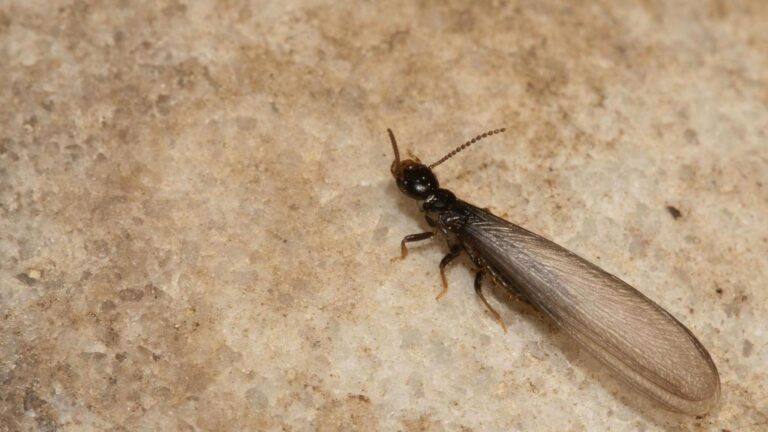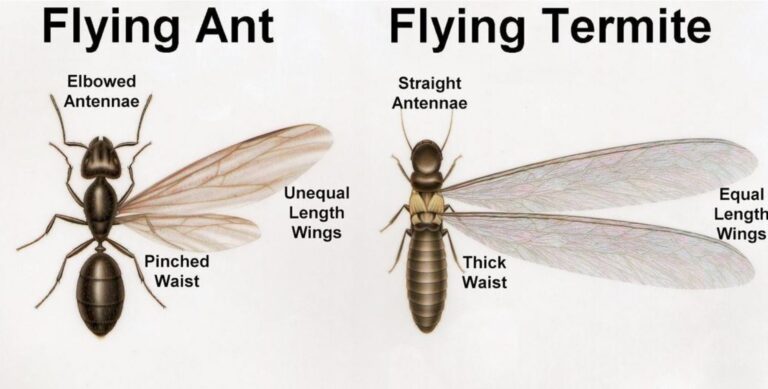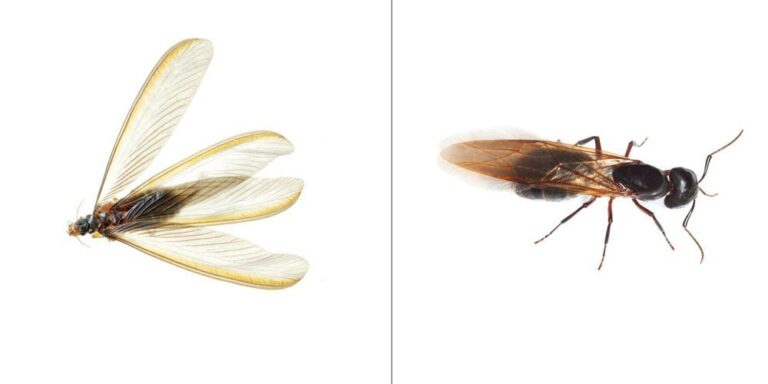Have you ever wondered what the difference is between a flying ant and a termite? With their wings and similar physiques, it can be hard to tell them apart at a quick glance. To make matters even more confusing, the environment they live in may also influence subtle distinctions in appearance.
It’s important to understand how these two insects are different from one another so that we can better appreciate both types of creatures and respect their respective roles in our ecosystem. In this blog post, we’ll provide an overview of each insect’s unique characteristics as well as helpful tips for identifying them when you spot them outdoors!

What Are Termites?
Termites are some of the most fascinating creatures in the animal kingdom. These small insects are social creatures that live in large colonies, often underground or within the structures they are infesting. They are known for their remarkable abilities to eat away at wood and other materials, causing serious damage to homes and buildings.
Despite their reputation as pests, termites play an important role in the ecosystem by breaking down dead plant matter and enriching the soil with nutrients. Termites come in over 2,700 different species, with each having its distinct physical appearance and behavior. Their impact on society and the environment is remarkable, and studying their behavior and biology can teach us a lot about the natural world around us.

What Are Flying Ants?
Flying ants, also known as alates, are a fascinating subgroup within the ant species. These remarkable insects possess wings and are capable of taking flight during specific stages of their lifecycle. While their appearance may resemble that of termites, there are distinct differences that set flying ants apart. Understanding the characteristics and behaviors of flying ants can help differentiate them from other winged insects and provide insight into their ecological significance.

How To Tell Them Apart?
Distinguishing between termites and flying ants can be challenging due to their similar appearance. However, observing certain characteristics can help differentiate them.
Termites possess straight, beaded antennae and a thick waist or segmented body, while flying ants have elbowed or bent antennae and a narrow waist or constricted body. Additionally, examining their wings can provide useful clues.
Following are some of the major key differences between the two:
Termites Have:
- Straight, beaded antennae
- Thick waist or segmented body
- Equal-sized forewings and hindwings
- Wings that are longer than their body length
- Light-colored or transparent wings
- Chewing mouthparts for consuming wood
- Nests made of soil, mud, or wood particles
Flying Ants Have:
- Elbowed or bent antennae
- Narrow waist or constricted body
- Forewings that are larger than hindwings
- Wings that are shorter than or equal to their body length
- Dark-colored or opaque wings
- Chewing or biting mouthparts for feeding on various food sources
- Nests located in soil, trees, or other crevices

Fun Fact: Did you know that Termites can bite humans if agitated?
Other Ways You Can Identify Termites and Flying Ants
There are additional factors to consider beyond what we have already discussed when distinguishing between termites and flying ants.
In this section, we’ll explore other ways to identify termites and flying ants, helping you differentiate between these two common insect species.
Appearance
While appearance is an important aspect in identifying termites and flying ants, there are additional characteristics to consider.
Termites typically have straight antennae, a thick waist, and straight wings of equal size.
Flying ants, on the other hand, have elbowed antennae, a narrow waist, and wings of different lengths, with the front pair being longer than the hind pair.
These variations in antennae, waist, and wings can provide valuable clues to differentiate between the two species.
Behavior
Understanding the behavior of termites and flying ants can also aid in distinguishing between them.
Termites are known for their destructive feeding habits and ability to cause significant damage to wooden structures. They build mud tubes to protect themselves while traveling and foraging for food.
On the other hand, flying ants are typically less destructive and are often observed during their mating flights, after which they shed their wings and establish new colonies.
Life Cycle
The life cycle of termites and flying ants also varies and can be another distinguishing factor.
Termites undergo a gradual metamorphosis, progressing from eggs to nymphs and finally becoming adult workers, soldiers, or swarmers.
Flying ants, however, are part of the reproductive caste in ant colonies and emerge during specific times for mating flights.
Understanding the life cycle stages of these insects can help you identify them more accurately.
Diet
Dietary preferences can also differ between termites and flying ants.
Termites primarily feed on cellulose-based materials like wood, paper, and plant matter, as they have specialized gut bacteria that aid in breaking down cellulose.
Flying ants, on the other hand, have a more varied diet and often feed on nectar, plant sap, or other insects.

Bottom Line
It is clear that flying ants and termites are very different in both structure and behavior. Flying ants, although related to other species, are solitary creatures that have adapted a lifestyle that is geared towards surviving the elements rather than being part of a larger society. Termites on the other hand are incredibly social and share roles within a community to ensure their continued survival.
These differences mean that it is unlikely we will ever see flying ants forming huge colonies like the ones formed by some species of termite. Although they may appear similar from afar, when you take a closer look there are plenty of differences between flying ants and termites. From wings and antennae to their diets and social dynamics, these two creatures are decidedly distinct entities for us to explore further!

